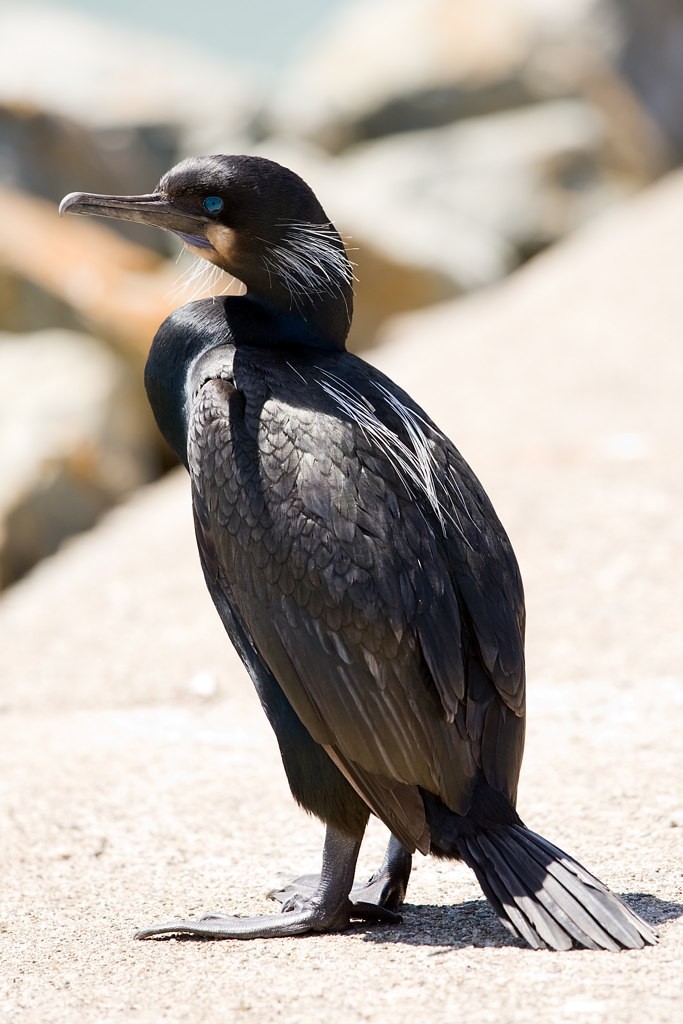Brandt's Cormorant
A species of Typical Cormorants and Shags Scientific name : Urile penicillatus Genus : Typical Cormorants and Shags
Brandt's Cormorant, A species of Typical Cormorants and Shags
Botanical name: Urile penicillatus
Genus: Typical Cormorants and Shags
Content
Description People often ask General Info
Description
Brandt's cormorant (Phalacrocorax penicillatus) is a strictly marine bird of the cormorant family of seabirds that inhabits the Pacific coast of North America. It ranges, in the summer, from Alaska to the Gulf of California, but the population north of Vancouver Island migrates south during the winter. Its specific name, penicillatus is Latin for a painter's brush (pencil of hairs), in reference to white plumes on its neck and back during the early breeding season. The common name honors the German naturalist Johann Friedrich von Brandt of the Academy of Sciences at St. Petersburg, who described the species from specimens collected on expeditions to the Pacific during the early 19th century. The average size of a Brandt's cormorant is 4.6 pounds. They have a length of about 34 inches and their wingspan is 4 feet. Brandt's cormorants feed either singly or in flocks, and are adaptable in prey choice and undersea habitat. It feeds on small fish from the surface to sea floor, obtaining them, like all cormorants, by pursuit diving using its feet for propulsion. Prey is often what is most common: in central California, rockfish from the genus Sebastes is the most commonly taken, but off British Columbia, it is Pacific herring. Brandt's cormorants have been observed foraging at depths of over 36.5 m (120 ft) . During the breeding season, adults have a blue throat patch. This species nests on the ground or on rocky outcroppings. Año Nuevo Island is an important seabird breeding colony in the Monterey Bay National Marine Sanctuary, hosting Brandt’s cormorants among other species of seabirds. 
Size
89 cm (35 in)
Colors
Black
Green
White
Blue
Life Expectancy
9.4 years
Nest Placement
Cliff
Clutch Size
1 - 6 eggs
Feeding Habits
Brandt's Cormorant dive to hunt visually for fish and squid. They can dive up to 230 feet deep, feeding either in flocks or solo. Prey, grasped and crushed with the bill, includes over 90 fish species like anchovy, rockfish, and herring, plus shrimp and crabs. They often forage with mixed-species feeding flocks.
Habitat
Brandt's Cormorant's habitat encompasses coastal regions with strong marine upwellings, commonly along the Pacific coast. They favour kelp beds, inlets, bays, and estuaries within 10 miles of shorelines, migrating to areas with intenser upwellings like those along the California Current during nonbreeding seasons. Roosting typically occurs on rocky coastlines, islands, and cliffs.
Nest Behavior
During nest construction, brandt's Cormorant males gather materials, which can include pilfering from others, with both sexes arranging the items throughout incubation. Nest building, egg-laying, and parental care take place during specific breeding times, following species-specific patterns.
Nest Characteristics
Brandt's Cormorant typically selects windward slopes of rocky islands, steep cliffs, and boulder areas for nest sites. Nests are circular bowls made from grass, moss, weeds, sticks, marine algae, and driftwood, averaging 13.8 inches in width and 6.1 inches in height, with a 7.8 inch wide and 3.5 inch deep interior.
Dite type
Piscivorous
People often ask
General Info
Feeding Habits
Bird food type
Behavior
Brandt's Cormorant engage in dynamic courtship rituals where males initiate by claiming territories and exhibiting aggressive threat displays. Once a male secures a territory, he starts nest construction and attracts females with bill-pointing and wing-waving displays. Pair bonding is typically annual, characterized by elaborate greeting displays of bill pointing, throat pouch inflation, and synchronized bill locking. Both sexes are invested in incubation and chick-rearing, reflecting their social nature. As proficient divers, brandt's Cormorant leap from water to dive, but uniquely, they do not adopt the widespread cormorant behavior of wing drying post-immersion.
Scientific Classification
Phylum
Chordates Class
Birds Order
Gannets and Relatives Family
Cormorants Species
Brandt's Cormorant 